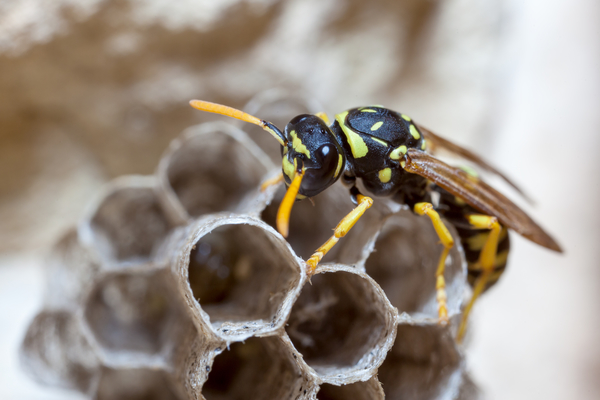Paper wasps tend to get a bad reputation because they’re known for stinging. You may even make it a point to avoid anything having to do with paper wasps. But what would you say if you knew they were beneficial to gardens?

Ready to learn more? Take a look at the following seven facts about paper wasps and discover how fascinating these insects really are.
What Is a Paper Wasp?
“Paper wasp” is the moniker given to several species of wasps that belong to the Polistes sub-family. As the name suggests, most paper wasps build their nests out of paper they make from chewing up wood and other vegetation.
Paper Wasp Identification
The easiest way to identify paper wasps is probably by their nests, which look like round, upside-down paper combs. The nests are attached to a horizontal surface by a single stalk and can grow in size as the colony reproduces. Some people say the nests look like umbrellas, which is why this insect is sometimes called an umbrella wasp.
What Do Paper Wasps Look Like?
Paper wasps can be anywhere from 0.5 to 1.5 inches long, though most come in around the 1-inch mark. Their colors can range from orange to reddish-brown to dark red, and some species have bright stripes that can be yellow and red. Unlike bees, however, they do not have fuzzy bodies.
Paper Wasps Are Good for Gardens
One of the most surprising facts about paper wasps is that they can benefit your garden. They sometimes feed on nectar, which helps with pollination, though they’re not nearly as effective as fuzzy-bodied bees. Additionally, adult paper wasps will often chew up those nuisance caterpillars in order to feed their wasp larvae.
The Queen Starts It All
A single fertilized queen is responsible for starting a new paper wasp nest. Once her first brood matures, they will expand the nest as needed. This brood becomes workers that forage for food and care for new larvae as the colony grows. In late fall or winter, the nests are abandoned. Fertilized queens are the only paper wasps to survive until spring, when those that survive establish a new colony.
They’re Not Out to Sting You…
Do paper wasps sting? You bet they do. However, it’s typically only when they feel their colony is threatened. So if you accidentally run into their nest or encroach on their territory, they’re going to do the only thing they can to protect their queen (sting), as she’s the key to future generations.
…But Their Stings Can Be Dangerous
While most people react to stings with some localized swelling and pain, some people are very allergic to wasp and bee stings. If someone with these allergies is stung, the Mayo Clinic recommends calling 911 if that person experiences:
- Difficulty breathing
- Swelling of the lips, eyelids or throat
- Dizziness, faintness or confusion
- Rapid heartbeat
- Hives
- Nausea, cramps or vomiting
Due to their stinging and aggressiveness when they feel threatened, you probably don’t want paper wasps living around your home. It’s not a good idea to remove a paper wasp nest on your own, as there’s a good chance you’ll be stung. Contact Terminix® so a trained technician can help you customize a paper wasp control and prevention plan.



